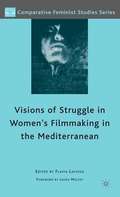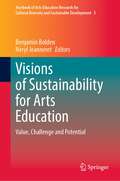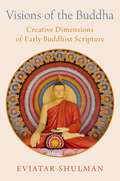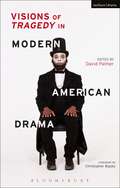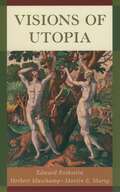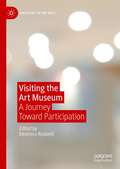- Table View
- List View
Visions of Struggle in Women's Filmmaking in the Mediterranean (Comparative Feminist Studies)
by F. LaviosaThis provocative collection elaborates a trans-cultural definition of being a woman in struggle. Looking at the films of women directors in countries in the Mediterranean rim, this book spurs a contemporary discussion of women s human, civil, and social rights while situating feminist arguments on women s identity, roles, psychology and sexuality. Although their methodologies are diverse, these artists are united in their use of cinema as a means of intervention, taking on the role as outspoken and leading advocates for women s problems. Contributors examine the ways in which cinematic art reproduces and structures the discourses of realism and represents Mediterranean women s collective experience of struggle.
Visions of Suburbia
by Edited by Roger SilverstoneSuburbia. Tupperware, television, bungalows and respectable front lawns. Always instantly recognisable though never entirely familiar. The tight semi-detached estates of thirties Britain and the infenced and functional tract housing of middle America. The elegant villas of Victorian London and the clapboard and brick of fifties Sydney. Architecture and landscapes may vary from one suburban scene to another, but the suburb is the embodiment of the same desire; to create for middle class middle cultures, middle spaces in middle America, Britain and Australia. Visions of Suburbia considers this emergent architectural space, this set of values and this way of life. The contributors address suburbia and the suburban from the point of view of its production, its consumption and its representation. Placing suburbia centre stage, each essay examines what it is that makes suburbia so distinctive and what it is that has made suburbia so central to contemporary culture. _
Visions of Suburbia
by Roger SilverstoneSuburbia. Tupperware, television, bungalows and respectable front lawns. Always instantly recognisable though never entirely familiar. The tight semi-detached estates of thirties Britain and the infenced and functional tract housing of middle America. The elegant villas of Victorian London and the clapboard and brick of fifties Sydney. Architecture and landscapes may vary from one suburban scene to another, but the suburb is the embodiment of the same desire; to create for middle class middle cultures, middle spaces in middle America, Britain and Australia. Visions of Suburbia considers this emergent architectural space, this set of values and this way of life. The contributors address suburbia and the suburban from the point of view of its production, its consumption and its representation. Placing suburbia centre stage, each essay examines what it is that makes suburbia so distinctive and what it is that has made suburbia so central to contemporary culture. _
Visions of Sustainability: Cities and Regions
by Hildebrand Frey Paul YaneskeThis book examines the sustainability of cities and regions and concludes that currently sustainability is not achievable. By identifying how cities and regions in the past have maintained or lost sustainability and how cities and regions of today might achieve sustainability in the future, it gives a clear definition, and an understanding of the true meaning, of sustainability provides a new conceptual framework for the assessment of the sustainability of cities and regions reveals what options are available for humankind to achieve or loose sustainability identifies research that will allow the systematic establishment of the appropriate indicators for sustainable development in cities and regions. Presenting a framework to guide and direct research in the measures needed to achieve and maintain sustainability, the book will be of considerable help to local authorities and political and government bodies responsible for establishing guidelines for the planning and monitoring of sustainable urban development. It will be of fundamental interest to ecologists, environmentalists, geographers, regional planners and urban designers, both in private practice and academia.
Visions of Sustainability: Cities and Regions
by Hildebrand Frey Paul YaneskeThis book examines the sustainability of cities and regions and concludes that currently sustainability is not achievable. By identifying how cities and regions in the past have maintained or lost sustainability and how cities and regions of today might achieve sustainability in the future, it gives a clear definition, and an understanding of the true meaning, of sustainability provides a new conceptual framework for the assessment of the sustainability of cities and regions reveals what options are available for humankind to achieve or loose sustainability identifies research that will allow the systematic establishment of the appropriate indicators for sustainable development in cities and regions. Presenting a framework to guide and direct research in the measures needed to achieve and maintain sustainability, the book will be of considerable help to local authorities and political and government bodies responsible for establishing guidelines for the planning and monitoring of sustainable urban development. It will be of fundamental interest to ecologists, environmentalists, geographers, regional planners and urban designers, both in private practice and academia.
Visions of Sustainability for Arts Education: Value, Challenge and Potential (Yearbook of Arts Education Research for Cultural Diversity and Sustainable Development #3)
by Benjamin Bolden Neryl JeanneretThis book stems from the 2019 meeting of the UNESCO UNITWIN international network for Arts Education Research for Cultural Diversity and Sustainable Development. It presents scholarly, international perspectives on issues surrounding arts education and sustainability that addresses the following questions: What value can the arts add to the education of citizens of the 21st century?; What are the challenges and ways forward to realize the potential of arts education in diverse contexts? The book discusses empirical research and exemplary practices in the arts and arts education around the world, presenting sound theoretical and methodological frames and approaches. It identifies policy implications at national, regional and global levels that cut across social, economic, environmental and cultural dimensions of sustainable development.
Visions of the Buddha: Creative Dimensions of Early Buddhist Scripture
by Eviatar ShulmanVisions of the Buddha offers a ground-breaking approach to the nature of the early discourses of the Buddha, the most foundational scriptures of Buddhist religion. Although the early discourses are commonly considered to be attempts to preserve the Buddha's teachings, Shulman demonstrates that these texts are full of creativity, and that their main aim is to beautify the image of the wonderous Buddha. While the texts surely care for the early teachings and for the Buddha's philosophy or his guidelines for meditation, and while at times they may relate real historical events, they are no less interested in telling good stories, in re-working folkloric materials, and in the visionary contemplation of the Buddha in order to sense his unique presence. The texts can thus be, at times, a type of meditation. Eviatar Shulman frames the early discourses as literary masterpieces that helped Buddhism achieve the wonderful success it has obtained. Much of the discourses' masterful storytelling was achieved through a technique of composition defined here as the play of formulas. In the oral literature of early Buddhism, texts were composed of formulas, which are repeated within and between texts. Shulman argues that the formulas are the real texts of Buddhism, and are primary to full discourses. Shaping texts through the play of formulas balances conservative and innovative tendencies within the tradition, making room for creativity within accepted forms and patterns. The texts we find today are thus versions--remnants--chosen by history of a much more vibrant and dynamic creative process.
Visions of the Buddha: Creative Dimensions of Early Buddhist Scripture
by Eviatar ShulmanVisions of the Buddha offers a ground-breaking approach to the nature of the early discourses of the Buddha, the most foundational scriptures of Buddhist religion. Although the early discourses are commonly considered to be attempts to preserve the Buddha's teachings, Shulman demonstrates that these texts are full of creativity, and that their main aim is to beautify the image of the wonderous Buddha. While the texts surely care for the early teachings and for the Buddha's philosophy or his guidelines for meditation, and while at times they may relate real historical events, they are no less interested in telling good stories, in re-working folkloric materials, and in the visionary contemplation of the Buddha in order to sense his unique presence. The texts can thus be, at times, a type of meditation. Eviatar Shulman frames the early discourses as literary masterpieces that helped Buddhism achieve the wonderful success it has obtained. Much of the discourses' masterful storytelling was achieved through a technique of composition defined here as the play of formulas. In the oral literature of early Buddhism, texts were composed of formulas, which are repeated within and between texts. Shulman argues that the formulas are the real texts of Buddhism, and are primary to full discourses. Shaping texts through the play of formulas balances conservative and innovative tendencies within the tradition, making room for creativity within accepted forms and patterns. The texts we find today are thus versions--remnants--chosen by history of a much more vibrant and dynamic creative process.
Visions of the Future in Roman Frontier Kingdoms 100 BCE–100 CE (Routledge Monographs in Classical Studies)
by Richard TeversonThis is the first book-length exploration of the ways art from the edges of the Roman Empire represented the future, examining visual representations of time and the role of artwork in Roman imperial systems.This book focuses on four kingdoms from across the empire: Cottius’s Alpine kingdom in the north, King Juba II’s Mauretania in the south-west, Herodian Judea in the east, and Kommagene to the north-east. Art from the imperial frontier is rarely considered through the lens of the aesthetics of time, and Roman provincial art and the monuments of allied rulers are typically interpreted as evidence of the interaction between Roman and local identities. In this interdisciplinary study, which explores statues, wall paintings, coins, monuments, and inscriptions, readers learn that these artworks served as something more: they were created to represent the futures that allied rulers and their people foresaw. The pressure of Roman imperialism drove patrons and artists on the empire’s borders to imbue their creations with increasingly sophisticated ideas about the future, as they wrestled with consequential decisions made under periods of intense political pressure.Comprehensively illustrated and providing an important new approach to Roman material culture at the edge of empire, Visions of the Future in Roman Frontier Kingdoms 100 BCE–100 CE is suitable for students and scholars working on Rome and its frontiers, as well as Roman material culture more broadly, and those studying the aesthetics of time in art and art history.
Visions of the Future in Roman Frontier Kingdoms 100 BCE–100 CE (Routledge Monographs in Classical Studies)
by Richard TeversonThis is the first book-length exploration of the ways art from the edges of the Roman Empire represented the future, examining visual representations of time and the role of artwork in Roman imperial systems.This book focuses on four kingdoms from across the empire: Cottius’s Alpine kingdom in the north, King Juba II’s Mauretania in the south-west, Herodian Judea in the east, and Kommagene to the north-east. Art from the imperial frontier is rarely considered through the lens of the aesthetics of time, and Roman provincial art and the monuments of allied rulers are typically interpreted as evidence of the interaction between Roman and local identities. In this interdisciplinary study, which explores statues, wall paintings, coins, monuments, and inscriptions, readers learn that these artworks served as something more: they were created to represent the futures that allied rulers and their people foresaw. The pressure of Roman imperialism drove patrons and artists on the empire’s borders to imbue their creations with increasingly sophisticated ideas about the future, as they wrestled with consequential decisions made under periods of intense political pressure.Comprehensively illustrated and providing an important new approach to Roman material culture at the edge of empire, Visions of the Future in Roman Frontier Kingdoms 100 BCE–100 CE is suitable for students and scholars working on Rome and its frontiers, as well as Roman material culture more broadly, and those studying the aesthetics of time in art and art history.
Visions of the Human: Art, World War I and the Modernist Subject (International Library Of Modern And Contemporary Art Ser.)
by Tom SlevinIn what ways do the artistic avant-garde's representations of the human body reflect the catastrophe of World War I? The European modernists were inspired by developments in the nineteenth-century, yielding new forms of knowledge about the nature of reality and repositioning the human body as the new 'object' of knowledge. New 'visions' of the human subject were created within this transformation. However, modernity's reactionary political climate – for which World War I provided a catalyst – transformed a once liberal ideal between humanity, environment, and technology, into a tool of disciplinary rationalisation. Visions of the Human considers the consequences of this historical moment for the twentieth and twenty-first centuries. It explores the ways in which the 'technologies of the self' that inspired the avant-garde were increasingly instrumentalised by conservative politics, urbanism, consumer capitalism and the society of 'the spectacle'. This is an engaging and powerful study which challenges prior ideas and explores new ways of thinking about modern visual culture.
Visions of the Past: The Challenge of Film to Our Idea of History
by Robert A. RosenstoneCan filmed history measure up to written history? What happens to history when it is recorded in images, rather than words? Can images convey ideas and information that lie beyond words? Taking on these timely questions, Robert Rosenstone pioneers a new direction in the relationship between history and film. Rosenstone moves beyond traditional approaches, which examine the history of film as art and industry, or view films as texts reflecting their specific cultural contexts. This essay collection makes a radical venture into the investigation of a new concern: how a visual medium, subject to the conventions of drama and fiction, might be used as a serious vehicle for thinking about our relationship with the past. Rosenstone looks at history films in a way that forces us to reconceptualize what we mean by "history." He explores the innovative strategies of films made in Africa, Latin America, Germany, and other parts of the world. He journeys into the history of film in a wide range of cultures, and expertly traces the contours of the postmodern historical film. In essays on specific films, including Reds, JFK, and Sans Soleil, he considers such issues as the relationship between fact and film and the documentary as visionary truth. Theorists have for some time been calling our attention to the epistemological and literary limitations of traditional history. The first sustained defense of film as a way of thinking historically, this book takes us beyond those limitations.
Visions of Tragedy in Modern American Drama
by David PalmerThis volume responds to a renewed focus on tragedy in theatre and literary studies to explore conceptions of tragedy in the dramatic work of seventeen canonical American playwrights. For students of American literature and theatre studies, the assembled essays offer a clear framework for exploring the work of many of the most studied and performed playwrights of the modern era. Following a contextual introduction that offers a survey of conceptions of tragedy, scholars examine the dramatic work of major playwrights in chronological succession, beginning with Eugene O'Neill and ending with Suzan-Lori Parks. A final chapter provides a study of American drama since 1990 and its ongoing engagement with concepts of tragedy.The chapters explore whether there is a distinctively American vision of tragedy developed in the major works of canonical American dramatists and how this may be seen to evolve over the course of the twentieth century through to the present day. Among the playwrights whose work is examined are: Susan Glaspell, Langston Hughes, Tennessee Williams, Arthur Miller, Edward Albee, Lorraine Hansberry, Amiri Baraka, August Wilson, Marsha Norman and Tony Kushner. With each chapter being short enough to be assigned for weekly classes in survey courses, the volume will help to facilitate critical engagement with the dramatic work and offer readers the tools to further their independent study of this enduring theme of dramatic literature.
Visions of Tragedy in Modern American Drama
by David PalmerThis volume responds to a renewed focus on tragedy in theatre and literary studies to explore conceptions of tragedy in the dramatic work of seventeen canonical American playwrights. For students of American literature and theatre studies, the assembled essays offer a clear framework for exploring the work of many of the most studied and performed playwrights of the modern era. Following a contextual introduction that offers a survey of conceptions of tragedy, scholars examine the dramatic work of major playwrights in chronological succession, beginning with Eugene O'Neill and ending with Suzan-Lori Parks. A final chapter provides a study of American drama since 1990 and its ongoing engagement with concepts of tragedy.The chapters explore whether there is a distinctively American vision of tragedy developed in the major works of canonical American dramatists and how this may be seen to evolve over the course of the twentieth century through to the present day. Among the playwrights whose work is examined are: Susan Glaspell, Langston Hughes, Tennessee Williams, Arthur Miller, Edward Albee, Lorraine Hansberry, Amiri Baraka, August Wilson, Marsha Norman and Tony Kushner. With each chapter being short enough to be assigned for weekly classes in survey courses, the volume will help to facilitate critical engagement with the dramatic work and offer readers the tools to further their independent study of this enduring theme of dramatic literature.
Visions of Utopia (New York Public Library Lectures in Humanities)
by Martin Marty Herbert Muschamp Edward RothsteinFrom the sex-free paradise of the Shakers to the worker's paradise of Marx, utopian ideas seem to have two things in common--they all are wonderfully plausible at the start and they all end up as disasters. In Visions of Utopia, three leading cultural critics--Edward Rothstein, Martin Marty, and Herbert Muschamp--look at the history of utopian thinking, exploring why they fail and why they are still worth pursuing. Edward Rothstein, New York Times cultural critic, contends that every utopia is really a dystopia--a disaster in the making--one that overlooks the nature of humanity and the impossibilities of paradise. He traces the ideal in politics and technology and suggests that only in art--and especially in music--does the desire for utopia find satisfaction. Martin Marty examines several models of utopia--from Thomas More's to a 1960s experimental city that he helped to plan--to show that, even though utopias can never be realized, we should not be too quick to condemn them. They can express dimensions of the human spirit that might otherwise be stifled and can plant ideas that may germinate in more realistic and practical soil. And Herbert Muschamp, the New York Times architectural critic, looks at Utopianism as exemplified in two different ways: the Buddhist tradition and the work of visionary Viennese architect Adolph Loos. Utopian thinking embodies humanity's noblest impulses, yet it can lead to horrors such as Nazi Germany and the Soviet Regime. In Visions of Utopia, these leading thinkers offer an intriguing look at the paradoxes of paradise.
Visions of Utopia (New York Public Library Lectures in Humanities)
by Edward Rothstein Herbert Muschamp Martin MartyFrom the sex-free paradise of the Shakers to the worker's paradise of Marx, utopian ideas seem to have two things in common--they all are wonderfully plausible at the start and they all end up as disasters. In Visions of Utopia, three leading cultural critics--Edward Rothstein, Martin Marty, and Herbert Muschamp--look at the history of utopian thinking, exploring why they fail and why they are still worth pursuing. Edward Rothstein, New York Times cultural critic, contends that every utopia is really a dystopia--a disaster in the making--one that overlooks the nature of humanity and the impossibilities of paradise. He traces the ideal in politics and technology and suggests that only in art--and especially in music--does the desire for utopia find satisfaction. Martin Marty examines several models of utopia--from Thomas More's to a 1960s experimental city that he helped to plan--to show that, even though utopias can never be realized, we should not be too quick to condemn them. They can express dimensions of the human spirit that might otherwise be stifled and can plant ideas that may germinate in more realistic and practical soil. And Herbert Muschamp, the New York Times architectural critic, looks at Utopianism as exemplified in two different ways: the Buddhist tradition and the work of visionary Viennese architect Adolph Loos. Utopian thinking embodies humanity's noblest impulses, yet it can lead to horrors such as Nazi Germany and the Soviet Regime. In Visions of Utopia, these leading thinkers offer an intriguing look at the paradoxes of paradise.
Visiting the Art Museum: A Journey Toward Participation (Sociology of the Arts)
by Eleonora RedaelliVisiting the Art Museum: A Journey Toward Participation is a book about the visitor experience. It is written as a companion for visitors to and inside the art museum. The volume engages readers in transforming a common experience, the museum visit, into a sophisticated epistemological inquiry. The study of the visitor experience through an epistemological approach consists of the untangling of the academic disciplines that study and inform each step of this experience: urban studies, architecture, design, art history, art education, and nonprofit management. This journey follows a transformative bottom-up trajectory from experiential to epistemological, and, finally, reveals itself as empowering. The book unfolds as an edited volume, with chapters by different authors who are enthusiastic scholars in each discipline and addresses undergraduate students as citizens, master’s students as professionals, and scholars as teachers and researchers. Each reader will discover a kaleidoscopic world made of ideas, values, and possibilities for participation.
Visitor Experience at Holocaust Memorials and Museums
by Diana I. PopescuVisitor Experience at Holocaust Memorials and Museums is the first volume to offer comprehensive insights into visitor reactions to a wide range of museum exhibitions, memorials, and memory sites. Drawing exclusively upon empirical research, chapters within the book offer critical insights about visitor experience at museums and memory sites in the United States, Poland, Austria, Germany, France, the UK, Norway, Hungary, Australia, and Israel. The contributions to the volume explore visitor experience in all its complexity and argue that visitors are more than just "learners". Approaching visitor experience as a multidimensional phenomenon, the book positions visitor experience within a diverse national, ethnic, cultural, social, and generational context. It also considers the impact of museums’ curatorial and design choices, visitor motivations and expectations, and the crucial role emotions play in shaping understanding of historical events and subjects. By approaching visitors as active interpreters of memory spaces and museum exhibitions, Popescu and the contributing authors provide a much-needed insight into the different ways in which members of the public act as "agents of memory", endowing this history with personal and collective meaning and relevance. Visitor Experience at Holocaust Memorials and Museums offers significant insights into audience motivation, expectation, and behaviour. It is essential reading for academics, postgraduate students and practitioners with an interest in museums and heritage, visitor studies, Holocaust and genocide studies, and tourism.
Visitor Experience at Holocaust Memorials and Museums
by Diana I. PopescuVisitor Experience at Holocaust Memorials and Museums is the first volume to offer comprehensive insights into visitor reactions to a wide range of museum exhibitions, memorials, and memory sites. Drawing exclusively upon empirical research, chapters within the book offer critical insights about visitor experience at museums and memory sites in the United States, Poland, Austria, Germany, France, the UK, Norway, Hungary, Australia, and Israel. The contributions to the volume explore visitor experience in all its complexity and argue that visitors are more than just "learners". Approaching visitor experience as a multidimensional phenomenon, the book positions visitor experience within a diverse national, ethnic, cultural, social, and generational context. It also considers the impact of museums’ curatorial and design choices, visitor motivations and expectations, and the crucial role emotions play in shaping understanding of historical events and subjects. By approaching visitors as active interpreters of memory spaces and museum exhibitions, Popescu and the contributing authors provide a much-needed insight into the different ways in which members of the public act as "agents of memory", endowing this history with personal and collective meaning and relevance. Visitor Experience at Holocaust Memorials and Museums offers significant insights into audience motivation, expectation, and behaviour. It is essential reading for academics, postgraduate students and practitioners with an interest in museums and heritage, visitor studies, Holocaust and genocide studies, and tourism.
The Visitors' Book: In Francis Bacon's Shadow: The Lives of Richard Chopping and Denis Wirth-Miller
by Jon Lys TurnerDenis Wirth-Miller and Dicky Chopping were a couple at the heart of the mid-twentieth century art world, with the visitors' book of the Essex townhouse they shared from 1945 until 2008 painting them as Zeligs of British society. The names recorded inside make up an astonishing supporting cast - from Francis Bacon to Lucian Freud to Randolph Churchill to John Minton. Successful artists, although not household names themselves, writing Dicky and Denis off as just footnotes in history would be a mistake. After Denis's death in 2010, Jon Lys-Turner, one of two executors of the couple's estate, came into possession of an extraordinary archive of letters, works of art and symbolically loaded ephemera the two had collected since they met in the 1930s. It is no exaggeration to state that this archive represents a missing link in British art history - the wealth of new biographical information disclosed about Francis Bacon, for example, is truly staggering. The Visitors' Book is both an extraordinary insight into the minutiae of Dicky and Denis's life together and what it meant to be gay in pre-Wolfenden Britain, as well as a pocket social history of the era and a unique perspective into mid-twentieth century art. With reams of previously unseen material, this is a fascinating and unique opportunity to delve into post-war Britain.
Visitors to the House of Memory: Identity and Political Education at the Jewish Museum Berlin (Museums and Collections #9)
by Victoria Bishop KendziaAs one of the most visited museums in Germany’s capital city, the Jewish Museum Berlin is a key site for understanding not only German-Jewish history, but also German identity in an era of unprecedented ethnic and religious diversity. Visitors to the House of Memory is an intimate exploration of how young Berliners experience the Museum. How do modern students relate to the museum’s evocative architecture, its cultural-political context, and its narrative of Jewish history? By accompanying a range of high school history students before, during, and after their visits to the museum, this book offers an illuminating exploration of political education, affect, remembrance, and belonging.
Visual Activism in the 21st Century: Art, Protest and Resistance in an Uncertain World
by Stephanie Hartle and Darcy WhiteThe world is in crisis, bringing activists and protesters onto the streets and into the public eye. More than ever, activism relies on spectacle and visibility in order to be noticed in the era of globalized capitalism and networked media. At the same time, a growing number of artists employ creative strategies to critique the establishment, act in resistance, and demand change. Visual activism of this kind is not new, but it is rapidly evolving.This anthology presents 16 case-studies of visual activism from across the globe, providing an up-to-date picture of the impact of contemporary visual and art activism, and combining a scholarly interrogation of visual activism with an examination of how it works in practice. The case studies address a wide range of issues including human rights abuses; state violence; gender and sexuality; racism; migration; and climate breakdown. They examine a range of approaches from playful carnivalesque parades to extreme practices such as 'lip-sewing', and are drawn from a wide range of international contexts – from Europe and the US, to Iran, India, Pakistan, Tunisia, and China. This diverse scope enables readers to consider examples comparatively – noticing emerging trends and key differences to reveal how geopolitical and cultural factors play an important role in shaping activist practices.This rich and timely collection provides a fresh perspective on the possibilities, limitations and politics of visual activism, as activists, artists, and curators respond to the changing world around them in this most uncertain of times.
Visual Activism in the 21st Century: Art, Protest and Resistance in an Uncertain World
The world is in crisis, bringing activists and protesters onto the streets and into the public eye. More than ever, activism relies on spectacle and visibility in order to be noticed in the era of globalized capitalism and networked media. At the same time, a growing number of artists employ creative strategies to critique the establishment, act in resistance, and demand change. Visual activism of this kind is not new, but it is rapidly evolving.This anthology presents 16 case-studies of visual activism from across the globe, providing an up-to-date picture of the impact of contemporary visual and art activism, and combining a scholarly interrogation of visual activism with an examination of how it works in practice. The case studies address a wide range of issues including human rights abuses; state violence; gender and sexuality; racism; migration; and climate breakdown. They examine a range of approaches from playful carnivalesque parades to extreme practices such as 'lip-sewing', and are drawn from a wide range of international contexts – from Europe and the US, to Iran, India, Pakistan, Tunisia, and China. This diverse scope enables readers to consider examples comparatively – noticing emerging trends and key differences to reveal how geopolitical and cultural factors play an important role in shaping activist practices.This rich and timely collection provides a fresh perspective on the possibilities, limitations and politics of visual activism, as activists, artists, and curators respond to the changing world around them in this most uncertain of times.
Visual Alchemy: The Fine Art Of Digital Montage
by Catherine McIntyreCatherine McIntyre, like many fine artists, created traditional art for decades before encountering the versatility of digital imaging technology. Free of her Rotring pens and scalpel, she now uses Photoshop to create her montages. Visual Alchemy explores McIntyre’s sources of inspiration as well as her methods, offering an aesthetic guide to composition, color, texture and all of the other means of communication that artists have at their disposal. While these concepts and techniques make use of Photoshop, they will apply to any digital imaging program and indeed to any medium, whether traditional or digital. Featuring McIntyre’s own art as well as that of artists around the globe, Visual Alchemy is an invitation to discover the artistic possibilities of picture making through digital montage.
Visual Alchemy: The Fine Art of Digital Montage
by Catherine McIntyreCatherine McIntyre, like many fine artists, created traditional art for decades before encountering the versatility of digital imaging technology. Free of her Rotring pens and scalpel, she now uses Photoshop to create her montages. Visual Alchemy explores McIntyre’s sources of inspiration as well as her methods, offering an aesthetic guide to composition, color, texture and all of the other means of communication that artists have at their disposal. While these concepts and techniques make use of Photoshop, they will apply to any digital imaging program and indeed to any medium, whether traditional or digital. Featuring McIntyre’s own art as well as that of artists around the globe, Visual Alchemy is an invitation to discover the artistic possibilities of picture making through digital montage.
